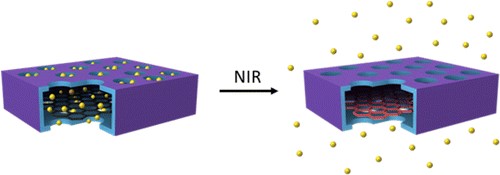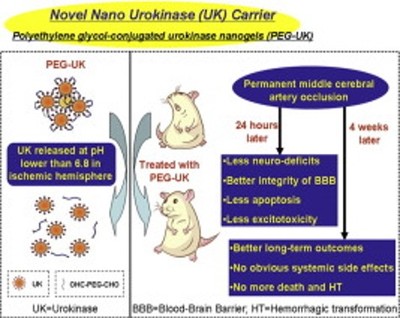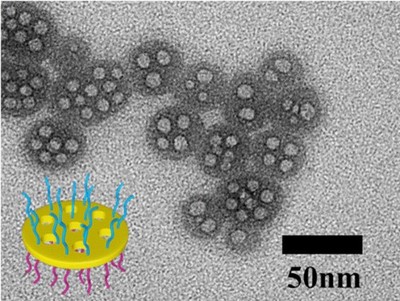1. Deng, Renhua; Li, Hui; Zhu, Jintao*; Li, Baohui*; Liang, Fuxin; Jia, Fan; Qu, Xiaozhong; Yang, Zhenzhong*. Janus Nanoparticles of Block Copolymers by Emulsion Solvent Evaporation Induced Assembly, Macromolecules, 2016, 49(4): 1362-1368.
We present a facile approach toward straightforward synthesis of Janus nanoparticles (NPs) of poly(4-vinylpyridine)-based block copolymers by solvent evaporation induced assembly within emulsion droplets. Formation of the Janus NPs is arisen from the synergistic effect between solvent selectivity and interfacial selectivity.This method is robust without the requisites of narrow molecular weight distribution and specific range of block fraction of the copolymers. Janus NPs can also be achieved from mixtures of copolymers, whose aspect size ratio and thus Janus balance are finely tunable. The Janus NPs are capable to self-assemble into ordered superstructures either onto substrates or in dispersions, whose morphology relies on Janus balance.

DOI:10.1021/acs.macromol.5b02507
https://pubs.acs.org/doi/abs/10.1021/acs.macromol.5b02507
2. Tang, Lin; Yang, Saina; Liang, Fuxin*, Wang, Qian; Qu, Xiaozhong; Yang, Zhenzhong*. Janus Nanocage Toward Platelet Delivery, ACS Appl. Mater. Interfaces, 2016, 8(19): 12056-12062.
The platelet-shaped Janus nano cages with a mesoporous silica shell are prepared. PEG moiety onto the exterior surface is responsible for good dispersity in water. The graphene sheet inside the cavity is responsible for hydrophobic performance to selectively capture hydrophobic species, and photothermal effect by NIR irradiation. As a biocompatible DOX-loaded Janus platelet delivery, HeLa cell cytotoxicity is greatly enhanced under NIR irradiation. There exists asynergetic effect between the chemotherapy and photothermal therapy.

DOI: 10.1021/acsami.6b03208
https://pubs.acs.org/doi/abs/10.1021/acsami.6b03208
3. Chen, Ying; Liu, Zhen; Qu, Xiaozhong; Liang, Fuxin*; Yang, Zhenzhong*. Janus Composite Nanotubes, Chem. Asian J., 2016, 11(12): 1785-1788.
We propose a facile method to achieve paramagnetic Janus nanotubes with two compositions compartmentalized onto the interior and exterior surfaces,respectively. A sulfonated polydivinylbenzene (PDVB) nanotube is prepared by simple sulfonation of the exterior surface of a PDVB nanotube. Silica@FeOOH dual layers are sequentially grown onto the sulfonated PDVB nanotube surface.The composite nanotubes become paramagnetic after calcination and can be broken into shorter pieces under vigorous ultrasonication. After selective modification of the interior and exterior surfaces of the paramagnetic nanotubes, the nanotube shell becomes Janus in wettability. Desired hydrophobic species can be selectively captured inside the cavity. The paramagnetic Janus composite nanotubes can align into parallel chains under a magnetic field,which is self‐disassembled upon removal of the magnetic field.

DOI:10.1002/asia.201600435
https://www.onlinelibrary.wiley.com/doi/10.1002/asia.201600435
4. Cui, Wei; Liu, Ran; Jin, Haiqiang; Lv, Pu; Sun, Yuyao; Men, Xi; Yang, Saina; Qu, Xiaozhong; Yang, Zhenzhong, Huang, Yining*. pH gradient difference around ischemic brain tissue can serve as a trigger for delivering polyethylene glycol-conjugated urokinase nanogels, J. Control. Release, 2016, 225(10): 53-63.
Background and Purpose: pH-sensitive polyethylene glycol-conjugated urokinase nanogels (PEG-UKs) were previouslyreported to be a new form of UK nanogels that could release UK at certain pH values. In this study, we evaluated the effect of PEG-UK targeted to ischemic tissue with microcirculation failure in rat model of ischemic stroke and investigated the possible mechanisms of action.
Methods: Surgeries were performed to induce persistent middle cerebral artery (MCA) occlusion in adult Sprague-Dawley rats.The pH distribution in the brain was mapped 1 h after ischemia using a needle-type pH micro sensor. The release curve of active UK from PEG-UK was also mapped by a continuous measurement of the peripheral blood. The thrombolytic effects of PEG-UK, when it was administrated 1 h after occlusion,including dynamic changes in the D-dimer level, neurological deficits and infarction volume, were observed. Next, the possible mechanisms underlying these effects were explored, including the BBB integrity and the extent of apoptosis and neurotoxicity. Additionally, the long-term effects of PEG-UKduring the four weeks after treatment were evaluated using the dynamic changes in the body weights and clinical scores and the numbers of deaths andhemorrhagic transformations (HTs). To evaluate the systemic side effects ofPEG-UK, the fluctuations of cytokines in the liver and kidney were evaluated.

DOI:10.1016/j.jconrel.2016.01.028
https://www.sciencedirect.com/science/article/pii/S0168365916300244
5. Jia, Fan; Liang, Fuxin; Yang, Zhenzhong*. Janus Mesoporous Nanodisc from Gelable Triblock Copolymer, ACS Macro Lett., 2016,5(12): 1344-1347.
The polymer/inorganic composite trilayered Janus mesoporous nanodiscs are synthesized by co-assembly of gelablepoly(ethylene oxide)-block-poly(3-triethoxysilylpropyl methacrylate)-block-polystyrene(PEO-b-PTEPM-b-PS) and PEO-b-PS via a sol-gel process at an emulsion interface Bimodal phase separations are responsible for the formation of isolated nanodiscs and mesopores within the discs. The Janus mesoporous nanodiscs are amphiphilic to form superstructures in dispersions. They can serve as a solid surfactant to stabilize emulsions.

DOI:10.1021/acsmacrolett.6b00812
https://pubs.acs.org/doi/abs/10.1021/acsmacrolett.6b00812
6. Yao, Xiaohui; Jing, Jingyun; Liang, Fuxin; Yang, Zhenzhong*. Polymer-Fe3O4 Composite Janus Nanoparticles, Macromolecules, 2016,49(24): 9618-9625.
A Fe3O4 nanoparticle (NP) based on composite Janus NP with single polymer chain is prepared by termination of the modified Fe3O4 NP with the anionic living polymer chain. The requisite that the polymer chain should be sufficiently large over the NP diameter determines the grafting of single polymer chain. From the opposite side of the NP surface,functional species can be selectively grown for example grafting responsive PNIPAM by ATRP. Besides simple combination of the thermal and magnetic responsive performances of different components, the PS-Fe3O4-PNIPAM composite Janus NP shows additional interactive performance such as NIR-triggered Janus/hydrophobic transition at low surrounding temperature below LCST similar to 32 degrees C.

DOI:10.1021/acs.macromol.6b02004
https://pubs.acs.org/doi/abs/10.1021/acs.macromol.6b02004
7. Zhang, Hang; Wang, Qiang*, Jiang, Bingyin; Liang, Bingyin; Yang, Zhenzhong*. Coral-like Janus Porous Spheres, ACS Appl. Mater. Interfaces, 2016, 8(48): 33250-33255.
A Janus porous sphere with a coral-like microstructure is prepared by stepwise dealloying a metallic alloy sphere and sequential modification (for example, using silanes and polymers). Nanoscale coral-like microstructure of the internal skeleton gives remarkable capillary force, thus accelerating the mass transportation. Starting from the outer layer of the sphere, stepwise dealloying can achieve different layers inwardly, thus introducing different composition and performance. As an example, poly(ethyleneglycol) poly(N-isopropylacrylamide) (PEG-PNIPAM)- and poly(ethylene glycol)poly(N,N-diethylamino-2-ethylmethacrylate) (PEG-PDEAEMA)-responsive Janus porous spheres can quickly capture oil by simply changing temperature or pH.Similarly, release is also triggered.

DOI:10.1021/acsami.6b12472
https://pubs.acs.org/doi/abs/10.1021/acsami.6b12472